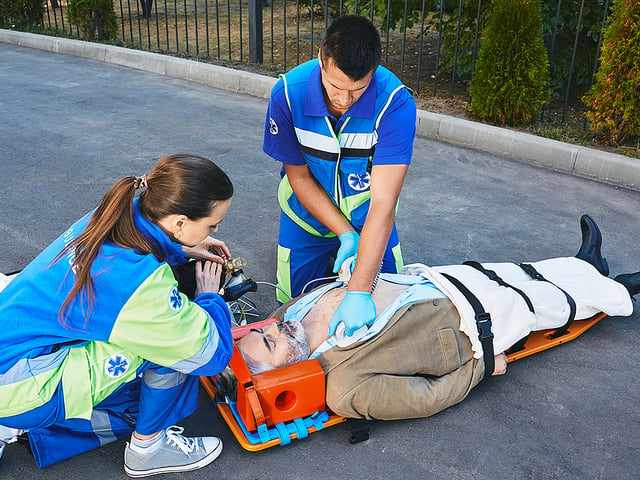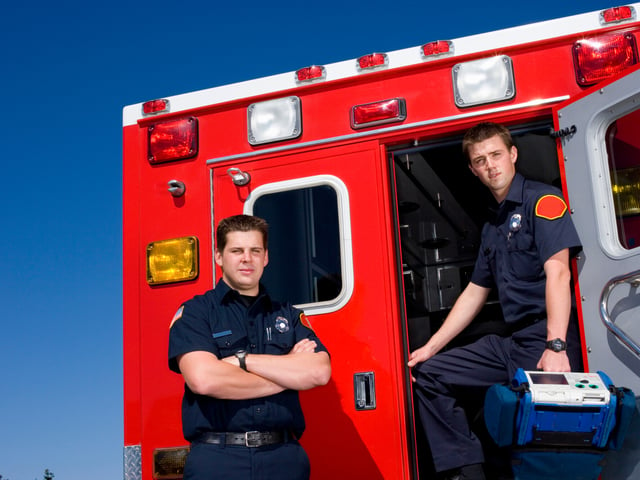
Your Complete Guide on How to Become an EMT
Have you decided to become an EMT? If so, you’ll be joining the modern-day heroes on the frontline.
According to the U.S. Bureau of Labor Statistics, employment of EMTs is expected to grow 11 percent by 2030, faster than the average for all occupations.
Emergency Medical Technicians (EMTs) are at the forefront of emergency medical care. They respond to emergency calls, perform medical services, and transport patients to medical facilities.
Becoming an EMT requires specialized training and experience that can take between six months and three years to complete.
If you’re considering a career as an EMT, learn everything you need to know here.
What Is an EMT?
An EMT is a health professional that provides essential emergency medical care and transportation services. EMTs are often employed in various settings, including private ambulance services, governments, hospitals, fire departments, and police departments.
EMTs have specialized training and skills to perform life-saving care. As such, the career is not for the faint of heart. It demands unwavering dedication, compassion, and an ability to navigate challenging situations.
What Does an EMT Do?
Aside from civilians, EMTs are often the first responders on the scene. They must remain calm during stressful situations and transport patients to medical facilities as safely and efficiently as they can.
An EMT is responsible for examining and evaluating patients to determine necessary care. An EMT might provide basic first aid to an elderly patient before responding to a serious road accident with multiple casualties on any given day.
For the most part, EMTs operate out of ambulances and are directed to emergencies by 911 operators.
EMT Salary
According to Indeed, the average base salary for an EMT in the U.S. is $49,707. This works out to be around $21.34 per hour.
Keep in mind salary ranges can vary depending on many factors, including education, certifications, additional skills, and previous experience.
As for benefits, employed EMTs report one or more of the following:
-
401(k)
-
Continuing education credits
-
Dental insurance
-
Disability insurance
-
Flexible schedule
-
Health insurance
-
Opportunities for career advancement
-
Paid sick time
-
Life insurance
-
Tuition reimbursement
-
Vision insurance
-
Referral program
-
Pet insurance
-
Relocation assistance
Benefit offerings vary widely from company to company and state to state.
With training and experience, you can advance in your career and earn higher pay. But for most people, becoming an EMT is not about the money. It’s a life-long career choice where you’re passionate about helping people who need it the most.
What’s the Job Outlook for EMTs?
As briefly mentioned earlier, the job outlook for EMTs is strong. The job growth rate of 11 percent by 2030 is expected to create 28,600 jobs for certified EMTs.
These reassuring figures are most likely representative of the country’s growing and aging population, which will require more emergency services.
The pandemic has also prompted healthcare industry leaders to boost EMT numbers to offset the growing number of sick and quarantined EMT personnel.
How to Become an EMT
To become an EMT, there are a few requirements you will need to be aware of. While EMTs don’t require bachelor’s degrees, they must complete several steps before receiving their EMT credentials.
1. Complete Basic Educational Requirements
Most EMT programs require a high school diploma or General Education Development (GED). If you don’t have either, you will need to finish high school or pass a GED exam. You must also be at least 18 years old.
2. Gain CPR Certification
Most EMT training programs will require you to gain your CPR certification. This certification is separate from the EMT training course, although most EMT programs will cover CPR in their training. You can earn your CPR certification in person, online, or blended learning class formats.
Generally speaking, completing your CPR certification online is the fastest option.
3. Complete an EMT Program
Aspiring EMTs must complete an accredited and state-approved EMT training program to be considered for certification. EMT training will teach you life support techniques, including CPR, tourniquet application, and wound treatment.
To obtain certification, EMTs must complete 120 to 150 hours of training.
4. Pass the Cognitive Exam
Once you have passed your EMT program, you will be eligible to take the EMT exam. There are two parts of the exam– a cognitive (written) and a psychomotor skills test.
The cognitive portion is a computer adaptive test, which means each question you’re given is based on your answers to the previous questions.
The test consists of between 60 and 110 questions that cover major concepts such as airway, respiration, and ventilation, cardiology and resuscitation, and medical and obstetrics/gynecology.
You will have two hours to complete the exam.
5. Pass the Psychomotor Exam
Following the cognitive test, you will need to take the psychomotor skills portion, which includes hands-on practical tasks.
The psychomotor exam requires you to demonstrate your ability to perform a range of emergency skills such as:
-
Patient assessment/management
-
Cardiac arrest management
-
Long bone fracture immobilization
-
Joint dislocation immobilization
-
Traction splinting
-
Bleeding control/shock management
-
Upper airway adjuncts and suction
-
Mouth-to-mouth ventilation with supplemental oxygen
The psychomotor skills part is conducted at a state level and may vary. To find out more, check with your state’s EMT office to find out where tests are administered and what score you need to pass.
Qualities and Skills for EMTs
To work as an EMT, you will need to have several essential qualities and skills to deal with the different scenarios you will encounter during your career. The following attributes will make you an excellent candidate to pursue a career as an EMT.
Physical Stamina
You will be required to sit, kneel, bend, stand, and reach out for long periods on every shift. You will also have to lift, pull and push patients of all sizes, sometimes alone or with the help of a fellow EMT. As a result, you need to have a high degree of physical fitness and strength.
Problem Solving
Problem-solving skills are crucial when it comes to assessing and diagnosing patients accurately. As an EMT, no two days are the same. You will need to think on your feet and make quick decisions to provide the best emergency care possible.
Communication
Being able to communicate effectively is an important skill to master. EMTs must be able to communicate with patients in highly stressful situations. They must also clearly communicate information to hospitals and fellow EMTs.
Patience
Not every patient you come across is going to be understanding. Patience is critical when dealing with members of the public. You also need patience during quiet periods and be prepared to attend life-threatening emergencies while keeping a cool head.
Stay Calm Under Pressure
EMTs must be constantly prepared to deal with stressful situations on the job. When you arrive on the scene, you must attend to people injured, in shock, or scared. Given the intense nature of the job, staying calm under pressure is an invaluable skill to possess.
Sense of Humor
Being an EMT can be highly stressful and can take its toll. On some days, you will be required to attend traumatic situations that aren’t for the faint of heart. Being able to laugh when the situation warrants it is recognized as having therapeutic value and is a coping mechanism against burnout.
Empathetic
EMTs constantly handle traumatic situations involving patients and concerned family and friends. Due to the nature of these situations, EMTs need to address the patient’s needs with empathy and compassion.
At the same time, EMTs must provide comfort and reassurance to friends and family members to ensure everyone feels supported.
What You Need to Know About the EMT Exam
Aspiring EMTs must complete and pass the EMT test to become certified. Before you take the test, you must complete an accredited EMT course. Upon completion, you can register for this exam.
As mentioned previously, the EMT test consists of two parts–a multiple-choice cognitive exam and a psychomotor skills portion.
The National Registry of Emergency Medical Technicians® developed the cognitive exam to determine whether the examinee understands information fundamental to becoming an EMT.
You can expect to answer anywhere from 70 to 120 questions, with 60 and 110 questions counted toward the final score. You will have two hours to complete the exam.
You will continually answer questions until the computer is 95% sure that you have met a standard (or above) level of competency to pass.
The exam will include essential concepts related to the EMT profession, including:
-
Airway, Respiration, and Ventilation
-
Cardiology and Resuscitation
-
Medical and Obstetrics/Gynecology
-
Trauma
-
EMS Operations
You should also expect questions related to geriatric and pediatric patient care.
The EMT test costs $80 per attempt. You can take the test up to six times. However, you can only take the retest 15 days after the last exam.
After three failed attempts, you must take a refresher course. After six failed attempts, you must repeat the entire EMT training program.
While it may be tempting to take the EMT test as soon as you have completed your training, this can result in mistakes and delay your EMT career.
As such, it’s important to take the time to study and be well-versed in the exam content.
Study Tools to Prepare for the EMT Test
Exams can be stressful, but being prepared can help manage stress and allow you to get the best result possible. Reviewing content in preparation for a test will fill in gaps in your understanding, explore complex concepts, and maximize your study time.
Union Prep Test understands how important a strong performance on the EMT test will have on your ability to perform duties as an EMT. Our free study materials will help you review all of the areas covered and identify areas you need to focus on.
EMT Practice Tests
Our free EMT practice tests are the perfect opportunity to simulate an exam environment. EMT practice tests give you an idea of the level of difficulty of the questions and an idea of the content, structure, and format of the exam.
It is a good idea to take the time to do a few practice tests before the actual exam. Many people recommend taking the practice test at the beginning of your study prep to give you a baseline of your knowledge.
After that, you can incorporate practice tests into your study routine to gauge how your learning is improving.
EMT Study Guides
Our free EMT study guide covers the most important material to study to help you frame your study prep efforts. For example, the Airway, Respiration, and Ventilation study guide provides information that covers only what you need to know to prepare for this particular section of the test.
EMT Flashcards
Flashcards are designed to promote active recall and are an effective study tool used by students of all ages. Our free EMT flashcards can help you reinforce concepts and information you have learned after studying each section thoroughly.
To memorize flashcards more efficiently, use mnemonic devices to create mental connections. You can also say your answers out loud or find a study companion to help test your knowledge (and theirs!).
Become an EMT With the Help of Union Test Prep
Becoming an EMT is a rewarding and challenging profession. As an EMT, you can potentially save someone’s life with educated and swift decision-making skills.
Before you become an EMT, you need to pass the EMT exam. While the test is designed to test your knowledge and skill, it doesn’t have to be impossible to pass.
With enough preparation, you can give yourself the best chance of retaining the information you need to pass the exam.
Union Test Prep can help you pass the EMT test. With our free practice tests, flashcards, and study guides, you can feel confident knowing you’ve done everything to take the EMT test successfully.
Start your EMT journey by studying with Union Test Prep today!
Keep Reading

Emergency Medical Technician Test Blog
How Many Questions are on the NREMT?
The National Registry of Emergency Medical Technicians (NREMT) exam is …

Emergency Medical Technician Test Blog
How Hard is the EMT Test?
EMTs (Emergency Medical Technicians) are required to have strong medica…

Emergency Medical Technician Test Blog
What Is a Passing Score on the NREMT Exam?
The job outlook for EMTs and paramedics is strong. The Bureau of Labor …